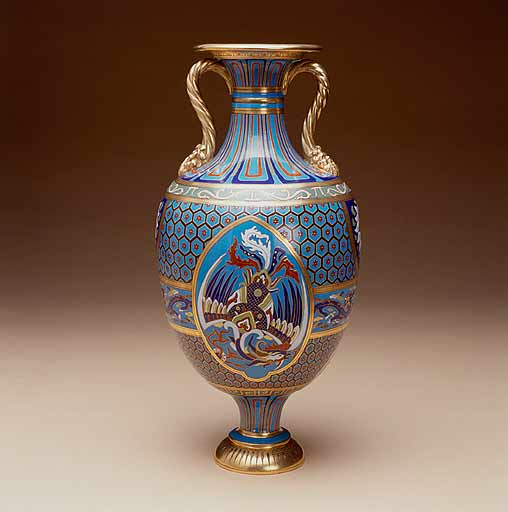vase
Summary
Vase, bone china, painted in overglaze enamels and gilding with chinoiserie pattern imitating cloisonne enamels. Amphora shaped with small foot, long tapering neck, flared rim and two twisted handles from underneath rim to shoulder terminating in Bacchic heads. Turquoise glazed ground decorated with a complex pattern of overglaze enamels and gilding simulating Chinese cloisonne enamels. Turquoise hexagons each containing a small red flower, and outlined in dark brown and gilding form a honeycomb design across the main body of the vase. Set with: two roughly oval medallions on opposite sides containing Chinese dragon and phoenix in red, blue, green, yellow and white with gilt outlining; an encircling band just below the middle with four dragons and Chinese hieroglyphs; a gilt outlined pendent lappet under each handle with a stylized floral motif set on a dark blue ground, each lappet with a smaller mirror image underneath the central band. Main body bordered at shoulder by a band of pink scrolling decoration and at base by a gilt geometric fret both on a green ground. Decoration at neck and foot of elongated vertical rectangles outlined in blue and red with green inserts, broken at neck of vase with encircling gilt and turquoise lines. Futher gilding on handles, and around the foot and the rim both with a differing black geometric pattern.
Display Label
Gallery text panel In Pursuit of Beauty Late Victorian Art and Design Improving the quality of British art and design had been a concern since the 1850s. The British Empire had expanded into new continents but it was the classical ideal of beauty, based on Ancient Greek and Roman culture that was still considered the model for serious art. The pursuit of beauty was a form of escapism from the mass-production of industrial Britain. As well as looking to the ancient world, artists and designers were delighted and inspired by the arts of Renaissance Italy, the Middle and Far East. Many of the paintings here feature a beautiful woman. Sometimes she is a passive, decorative form, but often she is a dark and brooding femme fatale, a symbol of seduction, deception and destruction. The 'fatal woman' may reflect late Victorian male fears as women campaigned for equal rights and new roles. The emphasis on colour, harmony and rhythm and simplifying the form of an object would become major concerns in the 20th century. They can be seen emerging here in the work of late Victorian artists and designers.
Object Name
vase
Creators Name
Date Created
1876=1880
accession number
1884.19
Collection Group
Place of creation
Stoke-on-Trent
Medium
Credit
Purchased
Legal
© Manchester Art Gallery

